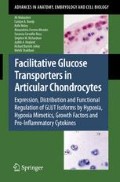The provision of nutrients and oxygen to synovial joints is essential for the physiological and load-bearing functions of articular cartilage and the homeostatic control of metabolism within chondrocytes, its resident cells (Mobasheri et al. 2002c; Mobasheri et al. 2006). The transport of nutrients (i.e., glucose, other hexose and pentose sugars, amino acids, nucleotides, nucleosides and water soluble vitamins such as vitamin C) into articular chondrocytes is essential for the synthesis of collagens, proteoglycans, and glycosaminoglycans by chondrocytes (Clark et al. 2002; Goggs et al. 2005; McNulty et al. 2005; Mobasheri et al. 2002a). There are numerous biological mechanisms by which nutritional factors might be expected to exert favorable influences on cartilage function and pathophysiological events in disease processes including osteoarthritis (McAlindon 2006). A decade ago, very little was known about nutrient transport in chondrocytes, particularly the transport of glucose, related sugars, and water-soluble vitamins, which are essential for the synthesis of glycosaminoglycans by chondrocytes. Glucose is a crucial nutrient for cartilage function in vivo as it is for many other tissues and organs. However, it has always been assumed that glucose is important for the in vitro cultivation of chondrocytes, ex vivo maintenance of cartilage explants, and cartilage tissue engineering procedures. No-one had actually studied the molecular mechanisms responsible for the uptake of glucose and glucose-derived vitamins such as vitamin C until the early 1990s when Bird and co-workers and Hernvann and colleagues studied the kinetics of glucose transport by chondrocytes and synovial fibroblasts in the presence and absence of proinflammatory cytokines (Bird et al. 1990; Hernvann et al. 1992, 1996). By the late 1970s it was well established that ascorbic acid supplementation was essential for maintaining sulfated proteoglycan metabolism in chondrocyte cultures and growth plate metabolism, hypertrophy, and extracellular matrix (ECM) mineralization (Gerstenfeld and Landis 1991; Schwartz and Adamy 1977; Schwartz et al. 1981). Studies by Otte and Hernvann related the importance of glucose as a metabolic substrate (Otte 1991) and emphasized the fact that glucose uptake is stimulated by catabolic cytokines in chondrocytes (Hernvann et al. 1992) and that stimulated glucose uptake is inhibited by anti-inflammatory cortisol (Hernvann et al. 1992, 1996). The last 8 years have seen significant progress in this area of connective tissue research although perhaps not compared to advances in our knowledge in other tissues. Therefore, the time has arrived in chondrocyte physiology and cell biology for recapitulation. Novel information gained about the physiological roles of transporters, particularly those involved in glucose uptake for essential metabolic and biosynthetic reactions in cartilage, and their regulation by hypoxia, growth factors, and cytokines, may contribute to a better understanding of the altered molecular and cellular mechanisms in cartilage pathologies such as osteoarthritis (OA) and osteochondritis dissecans (OCD). The aim of this monograph is to review the recently published information on the expression, distribution, and regulation of isoforms of the facilitative glucose transporter family (GLUTs) in articular chondrocytes and their stem cell precursors. We also explore the physiological implications of the functional regulation of these proteins by hypoxia, hypoxia mimetics, growth factors, and proinflammatory cytokines. This text also reviews our recent studies aimed at understanding the process of metabolic regulation in chondrocytes. In particular we discuss the functional expression of KATP channels in chondrocytes and their putative roles in the regulation of extracellular glucose and intracellular ATP sensing (Mobasheri et al. 2007). Glucose transport and metabolism in chondrocytes play key roles in the biology and physiology of articular cartilage. Glucose uptake is actually a major limiting step in glucose utilization by chondrocytes. Future progress in dealing with degenerative joint disorders such as OA, OCD, and related joint disorders will be highly dependent on a better understanding of the unique nutritional requirements of chondrocytes. Research is currently underway to determine if nutrient transport systems in chondrocytes and synoviocytes and related metabolic mechanisms and signaling pathways may offer suitable targets for modulating the behavior and biosynthetic activity of articular chondrocytes. A clearer knowledge of chondrocyte nutrition and the regulation of transport systems responsible for nutrient uptake in chondrocytes in health and disease may reveal underlying metabolic disturbances that are directly responsible for cartilage degradation in OA and other arthropathies. This knowledge will lead to new approaches and novel therapies to prevent and treat degenerative joint disease and enhance the approach for the discovery and design of drugs capable of modifying degenerative joint diseases.
Access this chapter
Tax calculation will be finalised at checkout
Purchases are for personal use only
Preview
Unable to display preview. Download preview PDF.
Rights and permissions
Copyright information
© 2008 Springer-Verlag Berlin Heidelberg
About this chapter
Cite this chapter
(2008). Introduction. In: Facilitative Glucose Transporters in Articular Chondrocytes. Advances in Anatomy, Embryology and Cell Biology, vol 200. Springer, Berlin, Heidelberg. https://doi.org/10.1007/978-3-540-78899-7_1
Download citation
DOI: https://doi.org/10.1007/978-3-540-78899-7_1
Publisher Name: Springer, Berlin, Heidelberg
Print ISBN: 978-3-540-78898-0
Online ISBN: 978-3-540-78899-7
eBook Packages: Biomedical and Life SciencesBiomedical and Life Sciences (R0)

